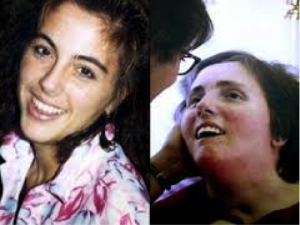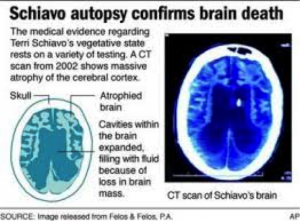Sanctity of Life Vs. Quality of life: Teri Schiavo
The cases this week made me draw from one of the most well known cases in “the right to die” realm. It is clear that the line between killing and letting someone die is a very blurred one ethically. Is becoming, in essence, a sideline spectator more morally justifiable than aiding in an act? What constitutes assistance with regard to nonmaleficence? Does this all boil down to semantics? The difference between quality of life and a life quality is also important to take into consideration. Sanctity subscribers would argue that life is life regardless of condition. (Thomas) While others in the quality camp would argue that life quality is marked by certain qualifiers. (Thomas) In the Koch article there is an interesting line with regard to surrogate perception. “The external determination of a diminished or unacceptable life quality is often not shared by the person whose life is being judged” (Koch). This is a truly disturbing thought because one is forced to question the line between discrimination against disabled persons via bias and fear, and a life that is unacceptable to the person. On one hand is maleficence and the other nonmaleficence.
Background:
Teri Schiavo was a young vibrant woman until 1990 when she suffered a heart attack that left her anoxic, completely oxygen deprived. The significant amount of brain damage led to a coma, which her doctors later updated to persistent vegetative state. (Perry 2005) Cumulous amounts of physical and speech therapy was tried with no success. Teri had no living will. After eight years her husband decided enough was enough and that Teri’s feeding tube should be removed, however her parents did not agree. Thus began a legal battle that would not conclude until 2005. This battle went all the way to the United States Supreme Court.
Who should act as a surrogate with regards to the principle of nonmaleficence? Teri’s husband says that his wife would not want to continue to exist in this state, and that since her state had not improved in fifteen years she should be allowed to die via starvation. Her family argues that it is a violation of human rights to purposefully starve a person, and that this decision preyed on her disability in line with some of Koch’s thought. Also that it was a violation of their Catholic faith to be euthanized via nutrient deprivation.
Course of Action:
With regards to nonmaleficence, I agree with the decision eventually came to by the supreme court to remove Teri’s feeding tube. Teri had been in a vegetative state for fifteen years her husband is the one that should be granted surrogacy. Her husband if deemed to be competent, in good standing with Teri prior to the accident, and not motivated by something else would have the best idea of her wishes. He would have the best idea if there is anything left in Teri’s life that she values, which constitutes quality of life (Thomas). Her brain activity suggested that she had been brain dead for a while now. With regards to maleficence there is very little harm being done by removing her feeding tube and letting nature take its course. Her parents argument that nutrient deprivation is against their religion is valid, however it can be argued and supported with text that this is just allowing her body to take its natural course. Also since she had no real choice in the matter her soul would be spared from judgment.
Sources
Perry JE, Churchill LR, Kirshner HS. The Terri Schiavo Case: Legal, Ethical, and Medical Perspectives. Ann Intern Med 143:744-748 (2005).
RD Koch, T. “Life quality vs ‘quality of life'” Social Science and Medicine 51 (3): 419-427 (2000)
Thomas, John E., Wilfrid J. Waluchow, and Elisabeth Gedge. Well and Good: A Case Study Approach to Health Care Ethics. 4th ed. New York: Broadview, 2014.


Every Bioethics class must discuss the “Teri Schiavo” case, because it incorporates numerous talking points. To begin with, the struggle to appoint a medical surrogate highlights the legal influence in cases, but it also challenges the students to “ignore” the law and to focus on morals. I agree with your proposition that the husband should have served as the medical surrogate due to his familiarity and relationship with the patient. In addition, Teri Schavio’s case forces students to examine the idea of “quality of life”. As you articulated, Teri suffered in a persistent vegetative state for eight years without improvement. As a result, the husband expressed that Teri was experiencing poor quality of life. Furthermore, one could argue that Teri was not experiencing “human life” at all. Although Teri’s heart was functioning, Teri did not have any cognitive function. As previously discussed in this course, cognitive capacity differentiates human life from other life. Therefore, one could argue that Teri no longer possessed the moral status of a human being. As a result, one could morally justify her death. Lastly, this case introduces the influence of religion in medical decisions. For example, Teri’s parents explained that death by nutrient deprivation violated their religious beliefs. Thus, by studying the Teri Schavio case, students can recognize the various factors causing dilemmas in medical ethics.